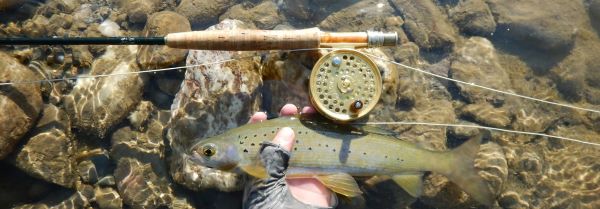Ever driven over a bridge, looked down into the river below, and wondered what the fishing would be like? After a quick glance up- and downstream, you make the call – yeah, it looks fishy! If you find yourself driving Highway 97 in northern B.C. between Prince George and Chetwynd, you cross a very fishy-looking river: the Pine.
The Pine meets up with Highway 97 at Pine Pass north of Prince George, and then flows towards Chetwynd. Distinct from any river you may have crossed further south, it holds Arctic grayling. And where there are Arctic grayling, you’re sure to have some excellent dry-fly fishing.

Starting in the Misinchinka Ranges near the Rocky Mountain Trench, the Pine flows east. Collecting water from the Sukunka and Murray rivers, it eventually empties into the Peace River near Taylor. The easiest river accesses off Highway 97 are west of Chetwynd, where you’ll find numerous pull-out spots, bridge crossings, and short drives down dirt roads.
Gearing Up for the Pine
Since the Pine is a small river, all you need is a 9-foot, 4-weight fly rod to cast fly patterns and play the grayling. While Arctic grayling can grow big – in excess of 50 centimetres (20 inches) in length – the majority you catch in the Pine are between 25 and 35 centimetres (10 and 14 inches); anything bigger would be an exceptional specimen.

The first thing you will notice about Arctic grayling is the sail-like dorsal fin. This big fin, along with its cobalt blue colouration, stands out among B.C.’s fish. A second distinctive feature is its smell of the herb thyme, which no doubt influenced Peter Pallas in 1776 to name Arctic grayling Thymallus arcticus. If you fish for grayling a few times, you will notice a third distinctive feature – their willingness to rise for dry flies. In the summer months, Arctic grayling are caught more on dry flies than by any other method.
Fly-Tying for Grayling
These fish rise eagerly to floating morsels. From the middle of July to early September, you can catch grayling on a variety of dry-fly patterns. To locate the fish, start working a pool or run with bigger attractor patterns like size 8 Stimulators or Chernobyl Ants. You will almost always get a reaction from a fish or two if they are there. Once you have found them, switch to smaller patterns, as grayling can struggle to take big bushy flies. In July, switch to size 10 Stimulators or size 12 Humpys in yellow or red. From August to September, grayling may get a little picky, and switching to even smaller dry flies like size 14 and 16 Adams can still fool them.

In runs with a little more current, Arctic grayling have a very characteristic rise when taking dry flies. They come to the surface, roll on the fly, and eat it on the way down. To best get a fish to hookup, wait for the line to tighten before lifting your rod tip.
Arctic grayling are enthusiastic surface strikers, and stream dry-fly enthusiasts love to play them. Remember that provincial freshwater fishing regulations require the use of barbless hooks on all rivers and streams. Be sure to practice proper catch-and-release techniques to maintain a population viable for fishing.
Author: Danie Erasmus
Photo Credit: Danie Erasmus, Brian Chan
Danie Erasmus lives in Prince George. In his spare time, he writes articles about fishing on streams, and operates a website: www.princegeorgeflyfisher.com dedicated to educating anglers about fly fishing. Danie also teaches a number of fly-fishing courses that range from beginner to more advanced levels.
Follow Danie on Instagram.
